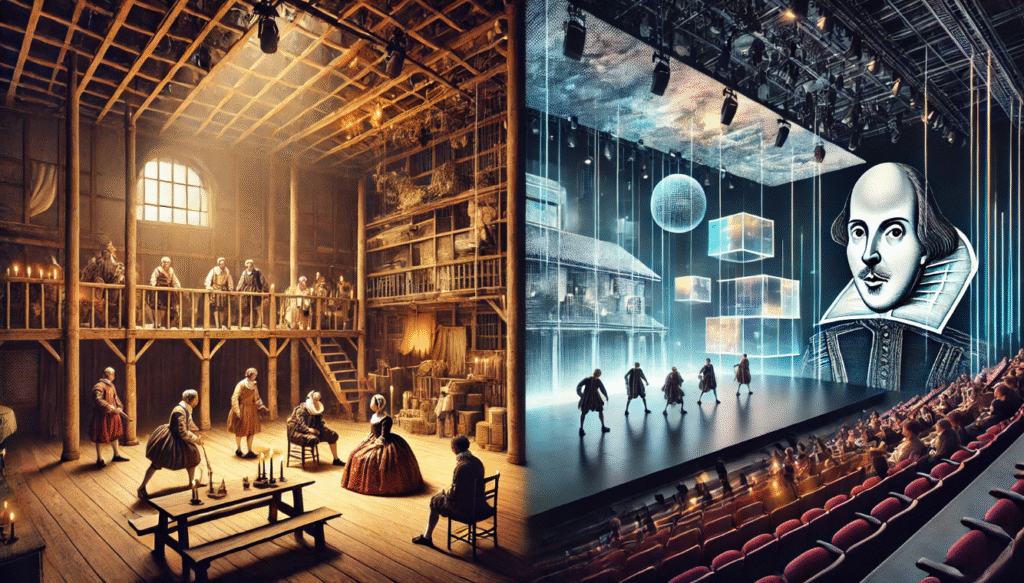
Understanding the Evolution of Shakespearean Stage Directions: How They Shaped Modern Theatre
Have you ever wondered how a 400-year-old script can still captivate modern audiences? 🎭 The secret lies in the evolution of Shakespearean stage directions. While many of Shakespeare’s plays were written with minimal instructions on how the actors should move or speak, these sparse directions have played a major role in shaping the theatrical world we know today.
For centuries, directors and actors have grappled with how to breathe life into these minimal clues, and over time, these interpretations have evolved into a rich tapestry of performance styles and techniques. In this article, we’ll explore how the simplicity of Shakespeare’s stage directions laid the groundwork for the dynamic and multifaceted performances in today’s theatre.
Table of Contents
ToggleWhat Are Shakespearean Stage Directions?
Shakespearean stage directions are the written instructions that guide actors and directors on how to perform certain actions in a play. 📝 But here’s the catch—Shakespeare didn’t give detailed notes on everything. Instead, his stage directions were often minimal, relying on the actors’ creativity and the director’s interpretation to fill in the gaps.
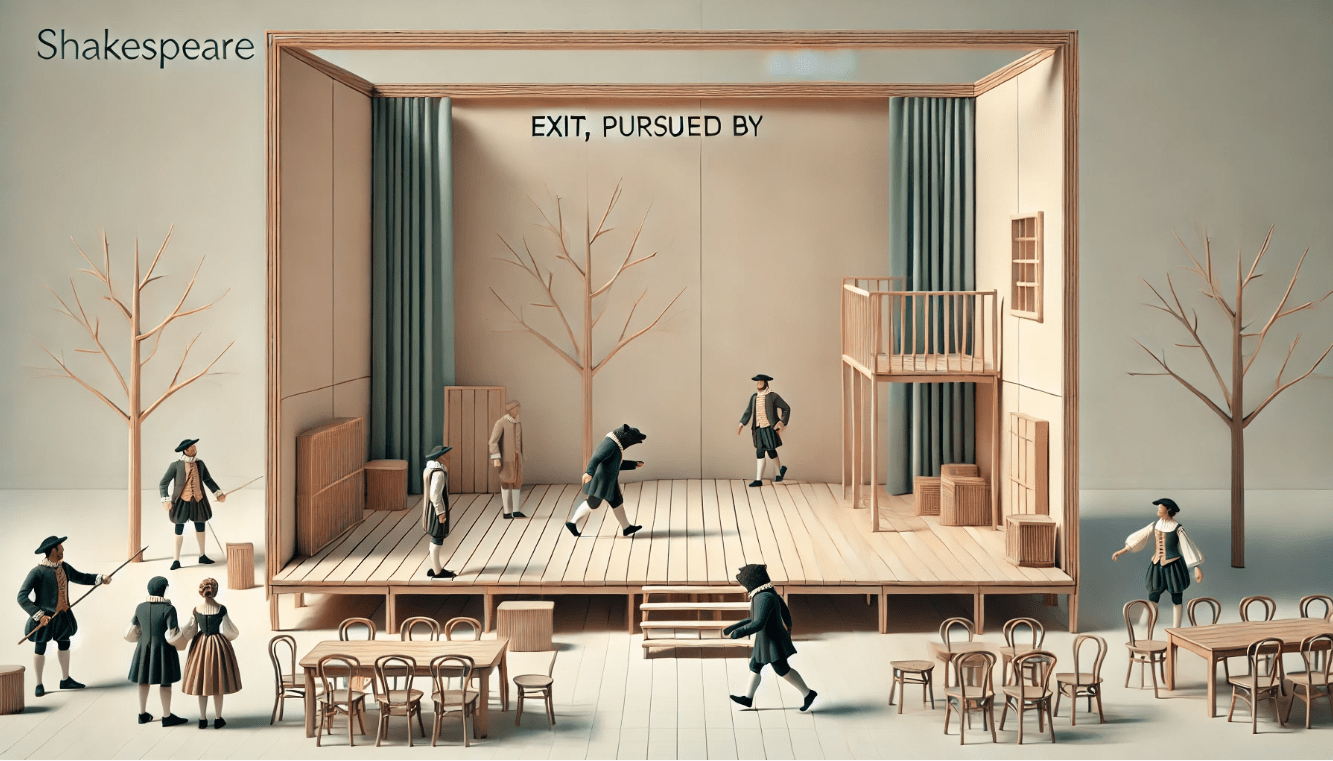
The Basics of Stage Directions
In simple terms, stage directions tell performers what to do, where to go, and how to interact with each other. They’re usually brief and can include things like:
- Enter/Exit: Who enters or leaves the stage, and when.
- Aside: A character speaks directly to the audience, without others hearing.
- Soliloquy: A long speech delivered by a character, typically alone on stage.
Shakespeare’s Approach to Stage Directions
Shakespeare’s stage directions were usually quite basic, often just a word or two. For example, you might see “Exit, pursued by a bear” in The Winter’s Tale. This sparse approach gave actors a lot of freedom to bring their own interpretation to the scene. While today’s stage directions are more detailed, Shakespeare’s minimalism encouraged creative performances, making his plays adaptable across different time periods and settings.
Why Did Shakespeare Keep Stage Directions So Simple?
One reason for Shakespeare’s minimalism is the limited technology of his time. In the Elizabethan theatre, there weren’t elaborate sets or advanced lighting effects. Most performances took place on a simple stage with minimal props. This meant that a lot of the visual storytelling had to come from the actors’ physicality and imagination. 🎭
The minimal stage directions allowed actors to use their bodies, voices, and emotions to fill in the gaps. This is why performances of Shakespeare’s works can vary widely: the stage directions leave room for interpretation, which gives each director and actor the freedom to create something unique.
Early Stage Directions: How Shakespeare Handled Movement and Action
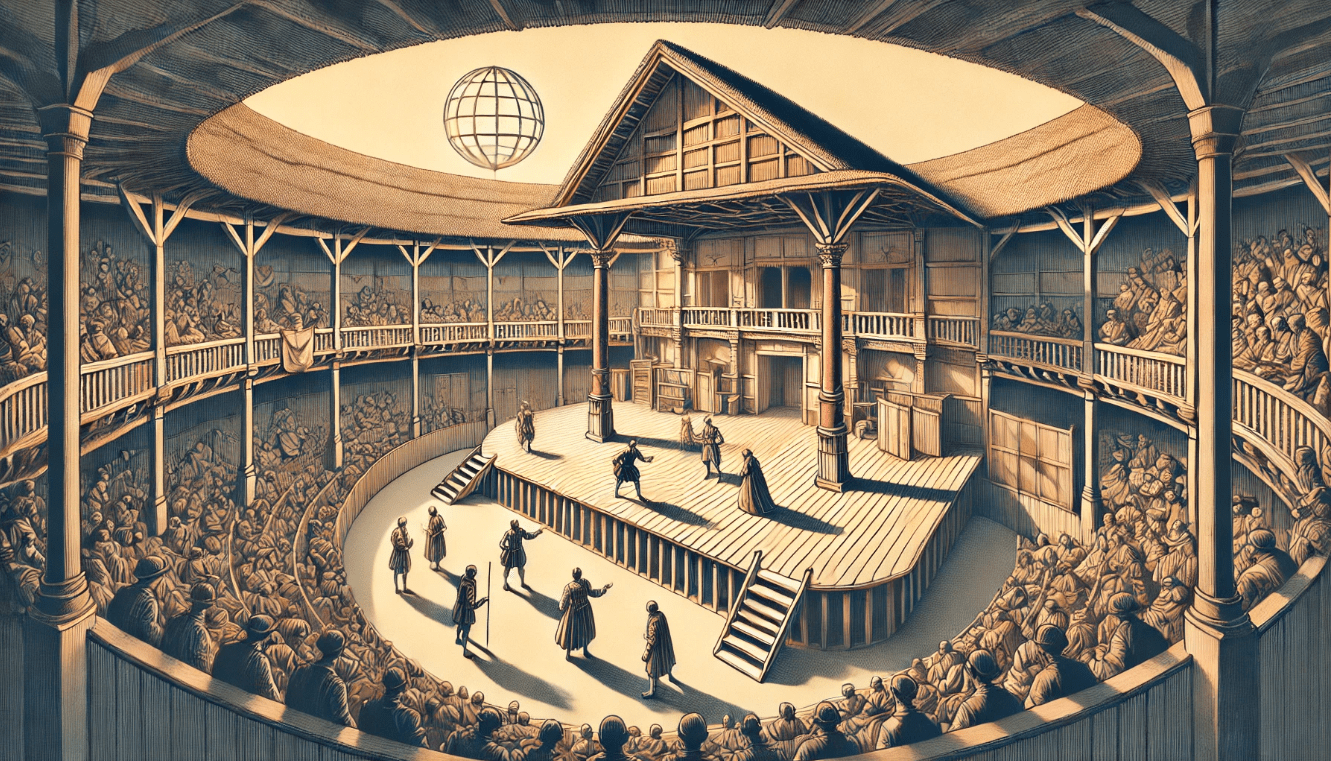
Shakespeare’s approach to stage directions was simple yet effective. 🎭 Instead of providing detailed instructions on every movement, Shakespeare left much of the action to the imagination of the actors and directors. This minimalistic approach not only reflected the limitations of the time but also gave room for creativity and adaptation.
Minimalism Was Key
In Shakespeare’s day, the theatre wasn’t equipped with advanced lighting, complex sets, or detailed stage machinery. The Globe Theatre, where many of his plays were first performed, had a simple stage with minimal props. This meant that the actors had to rely on their movements, voices, and physical gestures to tell the story. The stage directions, therefore, focused on the basics: who enters, who exits, and key moments of action.
For example, in Macbeth, stage directions like “Enter three Witches” or “Exit Macbeth” were all that was needed to set the scene. There weren’t any specific notes about how the witches should move, what they should wear, or the exact way Macbeth should exit. The actors and directors were free to interpret these moments based on the mood, the setting, and the vision for the production.
A Focus on Action Over Detail
Rather than giving detailed instructions, Shakespeare often used stage directions to signal crucial actions or dramatic moments. Take the famous line from The Winter’s Tale: “Exit, pursued by a bear.” This brief direction is striking for its simplicity but also its vividness. It tells us that something major is happening—someone is being chased—but leaves it to the actor and director to decide how to execute the scene, which can vary depending on the production.
Why This Worked in Early Productions
Shakespeare’s minimalist stage directions fit well with the performance style of the time. The actors relied on movement, voice, and emotion to convey meaning, and the audience was used to a more imaginative style of theatre. Much of the storytelling happened through dialogue, gestures, and body language. 🎤
The Evolution of Stage Directions in the Restoration and Beyond
After Shakespeare’s time, stage directions evolved significantly, especially during the Restoration period in the late 17th century. 🌟 The change was largely driven by advancements in technology, the professionalization of theatre, and the shift towards more elaborate productions. Let’s explore how stage directions became more detailed and specific, and how these changes shaped modern theatre.
The Shift to Detailed Stage Directions
During the Restoration (1660s), English theatre underwent a major transformation. Following years of political unrest and the closure of theatres during the English Civil War, the monarchy was restored, and so was public interest in theatre. 🎭 This period saw a move towards more structured and refined performances, which included not only detailed scripts but also elaborate stage directions.
Playwrights and directors began to realize the value of providing more specific instructions to help actors and crews navigate complex productions. Instead of leaving key actions open to interpretation, plays began to include detailed directions on character movements, emotions, and scene setups.
The Influence of European Theatre
At the same time, French Classical Theatre also influenced English stage directions. Playwrights like Molière and Racine were known for their structured, formulaic approach to theatre, which included clear guidelines for staging. This influence made its way across the English Channel, encouraging a more formalized approach to stage directions in England.
For example, playwrights like William Congreve and George Farquhar added more detailed blocking instructions in their scripts, such as when characters should move, sit, stand, or interact with props. These changes helped establish the foundation for the more sophisticated stagecraft we see in theatre today.
Technological Advancements and Stagecraft
As stage design evolved, so did the role of stage directions. The introduction of set designs, costumes, lighting, and special effects in the 18th century required more specific directions in order to coordinate all the elements effectively. 💡
Directors began to include more instructions on how the stage should be arranged and how actors should interact with the growing array of props and set pieces. For example, in a scene where an actor is meant to be “entering a grand hall,” the stage direction might specify the type of door to be used, the angle of lighting, or the positioning of other characters.
From Minimalism to Rich Detail
The evolution from Shakespeare’s sparse directions to these more detailed instructions marked a shift in how stage directions were viewed—not just as notes for actors, but as tools for creating immersive, fully realized productions. These developments paved the way for modern directors to craft performances that rely on not just dialogue, but a carefully choreographed blend of visual, auditory, and physical storytelling.
Shakespeare’s Influence on Modern Theatre Stage Directions
Even though stage directions evolved significantly after Shakespeare’s time, his influence is still deeply embedded in modern theatre. 🎭 Shakespeare’s minimalist approach to stage directions laid the groundwork for a flexible, creative approach to staging that continues to shape performances today.
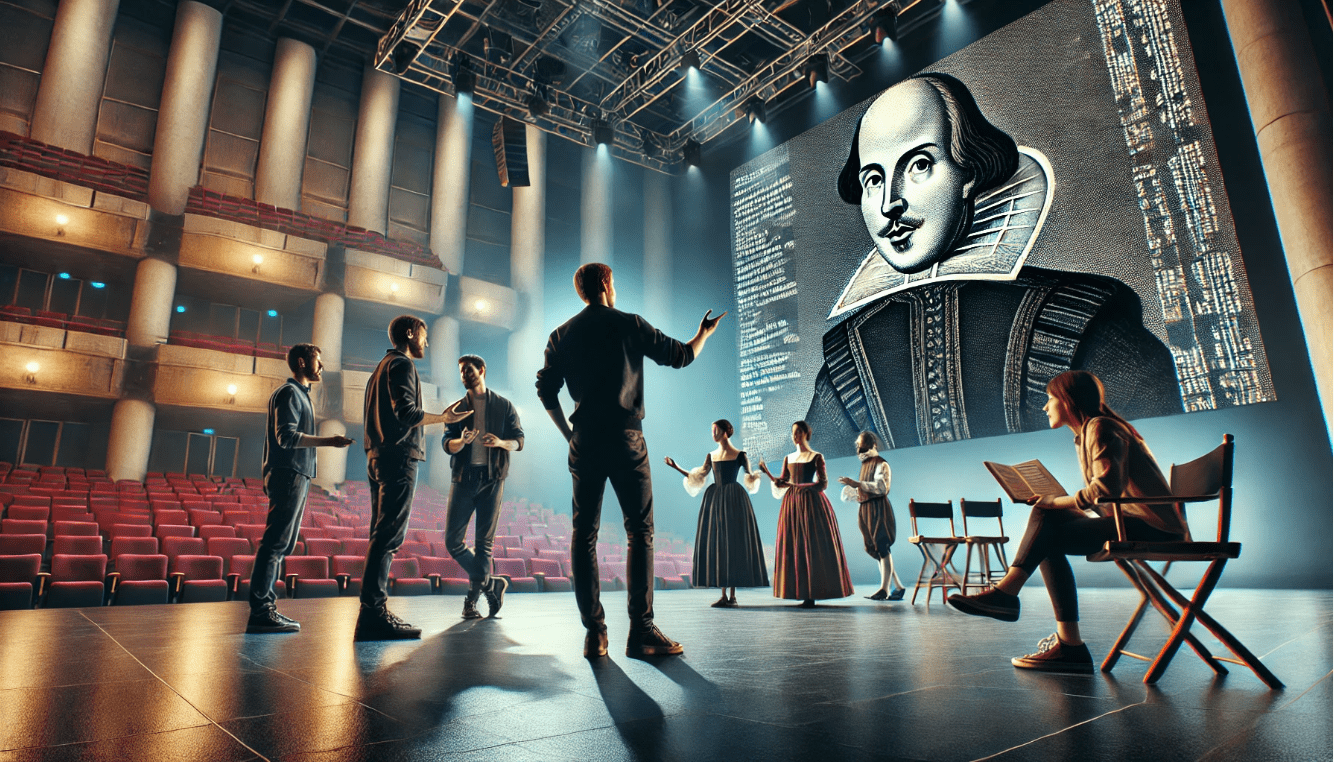
The Power of Interpretation
Shakespeare’s plays are famous for being performed in countless ways, and this flexibility stems from his sparse stage directions. Directors today can take Shakespeare’s basic instructions—like “Enter Hamlet” or “Exit, pursued by a bear”—and breathe new life into them, adapting the scenes for contemporary audiences. 🌍
Modern directors often make bold choices when interpreting these minimal directions, sometimes changing the setting, time period, or even the genre of the play. For instance, a director might set Macbeth in a futuristic dystopia or Romeo and Juliet in a 1920s gangster setting. This adaptability, rooted in Shakespeare’s open-ended directions, is one of the reasons his plays remain so relevant and widely performed across the globe.
Shakespeare’s Impact on Modern Performance Styles
In today’s theatre, actors continue to draw from Shakespeare’s minimalist approach to stage directions. Modern performances are no longer bound by strict rules. Instead, they rely on the actor’s ability to interpret the script, fill in the gaps, and bring their own creativity to the performance. 🎤
For example, Shakespeare’s famous soliloquies, like “To be or not to be” from Hamlet, are still interpreted in varied ways across productions. Some directors prefer a more traditional approach, with the actor alone on stage, while others experiment with using props, lighting, or even other characters to influence the performance. This diversity of interpretation is a direct result of the room Shakespeare’s original stage directions allowed for personal expression.
Shakespeare and Modern Directors: A Collaborative Relationship
Modern theatre directors, while often working with more detailed scripts, still embrace the creative freedom that Shakespeare’s minimalist stage directions inspired. They take inspiration from Shakespeare’s method of letting the action unfold naturally, leaving much to the actors’ instincts and interaction. 🎬
For example, in contemporary productions, directors may opt for more abstract or minimalist set designs, similar to the bare stages of Shakespeare’s time. This allows the actors to shine through, focusing the audience’s attention on their performance rather than overwhelming them with complex visuals. This approach keeps Shakespeare’s emphasis on physicality, expression, and movement at the heart of modern productions.
Shakespeare’s Legacy in Modern Innovations
Interestingly, Shakespeare’s influence also extends to cutting-edge performances, such as immersive theatre or digital performances. Even with the advancement of technology and stagecraft, Shakespeare’s influence remains strong. His plays are often used in innovative formats, like virtual or interactive theatre, where the minimal stage directions still provide a basis for creativity in digital spaces. 🌐
How Stage Directions Impact Performance and Interpretation
Stage directions are far more than just instructions for movement—they are key tools that shape the performance, direction, and overall impact of a play. Whether detailed or minimalist, stage directions guide actors, directors, and designers in bringing a story to life in a way that resonates with the audience. 🎭
The Actor’s Role: Bringing Stage Directions to Life
For actors, stage directions offer a foundation on which to build their performance. Even when Shakespeare’s directions are minimal, they are essential. These few words can tell an actor where to position themselves, how to interact with others, or what emotion to convey at a crucial moment.
For instance, a simple direction like “Exit, pursued by a bear” from The Winter’s Tale may seem basic, but it communicates a world of action. How the actor chooses to physically run, react to the imagined bear, or emotionally react to danger can completely change the tone and impact of that scene. The minimal direction opens up endless possibilities for interpretation and expression, allowing actors to inject their own creativity into the performance. 🌟
The Director’s Influence: Shaping the Story Through Stage Directions
Stage directions also play a crucial role in the director’s vision. Directors rely on these instructions to guide not just the actors, but also the blocking, the set design, and the pacing of the performance. A director interprets the script’s stage directions, filling in any blanks to ensure that the performance aligns with their creative vision.
For example, a director may choose to emphasize a character’s exit or entrance, highlighting a change in the emotional arc of the scene. Even the smallest actions, like a pause before a line or a character’s movement to a specific spot on stage, can make a huge difference in how the audience perceives a moment. Directors use stage directions to fine-tune the rhythm and flow of the play, helping to communicate the subtext and emotional beats that aren’t always spelled out in the script.
The Audience’s Experience: Creating Emotional Impact
The ultimate goal of stage directions is to guide the audience’s emotional journey. Whether subtle or bold, how a character moves on stage or interacts with their surroundings shapes the audience’s understanding of the narrative. This connection between the actor, the stage, and the audience is where the magic of theatre happens.
For example, when Shakespeare’s direction calls for a character to deliver a soliloquy or stand in a particular position, it’s not just about the physical movement—it’s about creating tension, drawing attention, and intensifying the audience’s emotional response. A character standing alone on stage while delivering a poignant speech can amplify their internal conflict, drawing the audience into their thoughts. ✨
Adapting to Modern Technology: New Dimensions of Interpretation
In today’s theatre, technology has added even more layers to how stage directions influence performance. Directors may now use lighting, sound effects, and digital projections to underscore stage directions. For example, when a play requires a “dark and stormy night,” modern lighting and sound can help bring this atmosphere to life, enhancing the emotional tone of the scene.
In addition, digital productions or immersive theatre experiences allow for even greater interaction. In these types of performances, the audience might be surrounded by the action, and stage directions could be interpreted in real-time based on their engagement with the performance. This innovative use of technology gives stage directions a whole new dimension, enabling interactive and dynamic performances. 💡
The Modern Shift: How Technology and Innovation Have Influenced Stage Directions
The world of theatre has dramatically changed over the years, and so has the role of stage directions. Today, technology and innovation are reshaping how stage directions are interpreted, offering new ways to enhance performance and storytelling. 🎬
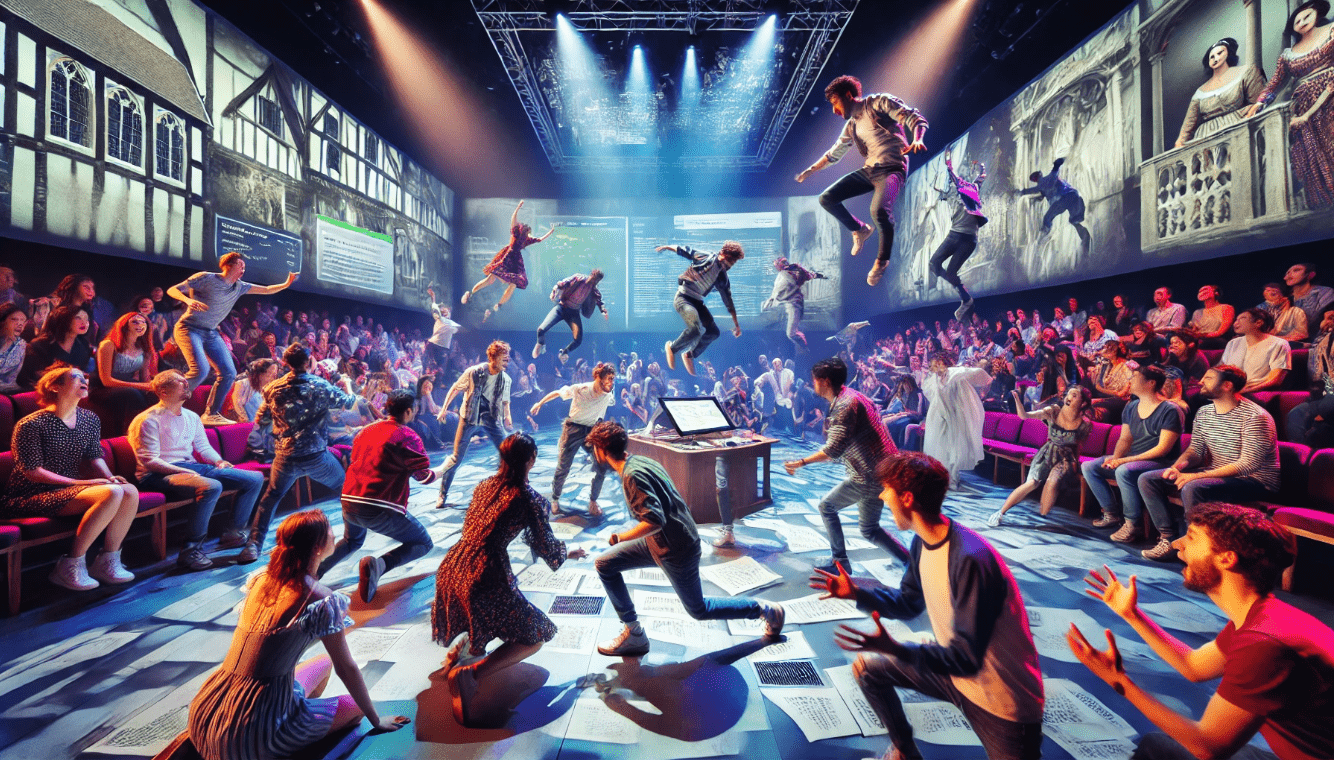
The Rise of Digital and Multimedia Theatre
One of the most significant shifts in modern theatre is the use of digital technology. From projections to interactive elements, technology has given stage directions a new layer of complexity. In productions today, stage directions no longer just refer to physical movement but can also include lighting cues, sound effects, and even visual projections.
For example, in a modern production of Macbeth, a director might use a digital storm to accompany the witches’ scene, making the atmosphere more immersive. The stage direction might simply read “Thunder,” but today, that can be brought to life with a mix of sound and digital effects. 🌩️
Interactive and Immersive Experiences
The growth of immersive theatre has also influenced stage directions. In immersive productions, the audience doesn’t just watch from a distance; they often interact directly with the actors or become part of the scene. Directors now have to include stage directions that account for audience participation, sometimes dictating where the audience can move or how they can engage with the performers. This creates a more dynamic, fluid interaction between performers and viewers, making the experience feel more personal and impactful.
For instance, in an immersive adaptation of Romeo and Juliet, a stage direction might say, “The audience is invited to join the dance floor during the masquerade ball.” This change moves beyond the traditional stage setup and brings new challenges for directors and actors alike.
Advanced Lighting and Set Design
Another significant advancement in modern theatre is the use of sophisticated lighting and set designs. These tools are now part of stage directions, with specific instructions about how the lighting should change during certain moments or how a set should transform. Stage directions now specify when a scene should be lit dramatically, when a shadow should cast over the stage, or how a set piece should move to convey a particular effect.
For example, in a contemporary production of Hamlet, the direction might include “Lights dim slowly as Hamlet contemplates the ghost.” This not only guides the actors but also allows the lighting designer to match the mood of the scene, making the performance feel richer and more emotionally engaging. 💡
Virtual and Hybrid Performances
The rise of virtual theatre and hybrid performances—where live theatre is combined with digital elements like streaming or virtual reality (VR)—has expanded the scope of stage directions. In a hybrid performance, stage directions could now include cues for virtual set changes, interactive online elements, or audience engagement through social media.
Imagine a King Lear production where the actor is on stage, but the set changes via digital projections, representing the character’s shifting mental state. The stage direction might say, “The walls of the castle begin to crumble digitally as Lear’s madness intensifies.” This kind of stage direction merges the physical world with the digital, allowing for entirely new types of performances.
Shaping Future Theatre
The future of stage directions will likely continue to embrace technology, pushing the boundaries of traditional theatre. Directors and actors will increasingly use new tools to enhance performance and allow for greater audience interaction. As technology advances, stage directions will become even more specific and varied, offering endless possibilities for how stories are told.
Practical Tips for Directors and Actors Working with Shakespeare’s Stage Directions
Shakespeare’s stage directions are often minimal, but that doesn’t mean they lack importance. In fact, these brief instructions can offer powerful insight into how to bring a production to life. Here are some practical tips for both directors and actors working with Shakespeare’s stage directions to create dynamic, engaging performances. 🎭
Tips for Directors
- Embrace the Freedom of Interpretation
Shakespeare’s minimalism allows directors to be creative. Instead of viewing the sparse directions as a limitation, use them as a launchpad for exploration. You can interpret key moments in unique ways, whether it’s through modern set design, contemporary themes, or innovative movement choices.
Example: In Macbeth, the direction “Enter Macbeth” is open to interpretation. You could choose to have Macbeth enter in a grand, dramatic fashion or, conversely, make it a subtle, quiet moment to reflect his inner turmoil. - Fill in the Gaps with Context
While Shakespeare’s directions are brief, they still imply much about the characters and their relationships. As a director, you have the task of adding context. Consider the emotional journey of each character and how their movements or actions can enhance the drama.
Example: If the direction says “Exit,” think about what happens when the character leaves. Is it a rushed exit? A calculated move? Does the exit change the flow of the scene or add tension? This small choice can shape the audience’s emotional response. - Collaborate with Designers and Actors
Directors should collaborate with lighting, sound, and costume designers to complement the minimal stage directions. For instance, using lighting to enhance the “mood” described in the text (such as dimming lights for Hamlet’s soliloquy) can provide a richer, more nuanced atmosphere. Similarly, costumes can help underscore character traits and mood, even if the script gives no specifics.
Example: When the stage direction says “Enter ghost,” the costume design and lighting should amplify the ghost’s eerie presence, reinforcing its impact on the characters and audience.
Tips for Actors
- Think Beyond the Words
Shakespeare’s minimal stage directions often leave room for personal interpretation. As an actor, think about how you can use body language, gesture, and tone of voice to add layers of meaning to your performance. These small actions can help create a more dynamic and believable character.
Example: When the stage direction calls for an “Aside,” think about how your body language can show that the character is confiding in the audience. Should you turn away from other characters, or perhaps speak more quietly to create intimacy? - Use Movement to Reflect Inner Conflict
Shakespeare’s stage directions often require actors to convey complex emotions through movement. For example, when a character “falls to their knees” or “turns away,” those movements are not just physical actions—they also symbolize emotional or psychological shifts. Use movement to mirror the inner workings of your character’s mind.
Example: In Hamlet, when Hamlet contemplates his fate, his “soliloquy” might be accompanied by slow, deliberate movements, reflecting the gravity of his thoughts. - Engage with the Space
While the script might not describe every interaction with the stage, it’s important to use the physical space to convey your character’s emotional state. Play with the distance between characters—are they physically close or distant? Does this physicality reflect their emotional connection or conflict?
Example: In Romeo and Juliet, the distance between Romeo and Juliet during their first meeting could subtly reflect their initial hesitancy, which later transforms into intense passion. - Collaborate with Fellow Actors
Shakespeare’s plays are full of dynamic interactions. Work closely with your fellow actors to build chemistry and respond to their cues—whether verbal or physical. Stage directions often suggest a moment of tension, a fight, or a quiet pause. Your reactions should feed off each other to create the emotional impact the playwright intended.
The Lasting Legacy of Shakespearean Stage Directions
Shakespeare’s stage directions may have been minimal, but their impact on theatre has been monumental. 🎭 From his simple instructions like “Exit” or “Enter,” Shakespeare laid the foundation for the way modern theatre uses stage directions to guide performances. As we’ve explored, these directions have evolved from basic cues to intricate and immersive tools for storytelling, but they continue to offer a canvas for creative interpretation.
Whether you’re a director drawing on Shakespeare’s flexibility to add your personal touch, or an actor using movement to bring out the deepest emotions of a character, understanding the evolution of Shakespearean stage directions enriches the way we approach the stage. Shakespeare’s minimalist style encourages freedom, creativity, and collaboration—qualities that are at the heart of every powerful performance today. 💡
As technology continues to reshape the world of theatre, the legacy of Shakespeare’s stage directions remains timeless. Modern innovations in lighting, digital effects, and interactive experiences may enhance the performance, but they all still rely on the fundamental principles of storytelling that Shakespeare set in motion.
So, whether you’re involved in a production of one of Shakespeare’s classics or tackling a new and innovative piece of theatre, remember that stage directions are not just instructions—they are an essential part of the story. They guide us, challenge us, and inspire us to push the boundaries of how theatre can be experienced. 🌟
Frequently Asked Questions (FAQs)
1. Why are Shakespeare’s stage directions so minimal?
Shakespeare’s stage directions were minimal because of the limitations of Elizabethan theatre. With basic stages and minimal props, directors and actors had more freedom to interpret the script and create the performance. This minimalist approach allowed for flexibility, giving actors and directors room to bring their unique vision to life.
2. How have stage directions evolved since Shakespeare’s time?
After Shakespeare, stage directions became more detailed, especially during the Restoration period. With advancements in set design, lighting, and technology, stage directions grew more specific, guiding actors and directors on precise movements, blocking, and scene transitions to create more immersive experiences for audiences.
3. How do modern directors interpret Shakespeare's minimal stage directions?
Modern directors interpret Shakespeare’s minimal stage directions by using their creativity to enhance the emotional and visual impact of the performance. They might update the setting, experiment with character movement, or incorporate new technologies like lighting and multimedia to make the stage directions more engaging and relevant to contemporary audiences.
4. What role do stage directions play in modern theatre performances?
Stage directions are crucial in modern theatre as they guide the actors’ movements, help with scene transitions, and provide context for the performance. They contribute to the emotional tone, pacing, and interaction between characters, making them essential for creating a cohesive and immersive theatrical experience.
5. Can Shakespeare’s stage directions be changed or adapted in modern productions?
Yes, Shakespeare’s stage directions can be adapted in modern productions to reflect contemporary styles or artistic interpretations. Directors often reimagine the staging, setting, or movement to suit the production’s vision while still maintaining the essence of the original play. This flexibility is one of the reasons Shakespeare’s works remain so adaptable and widely performed.
6. How do modern technologies influence stage directions?
Modern technologies, such as advanced lighting, sound effects, digital projections, and immersive experiences, have transformed stage directions. These tools can enhance atmosphere, create visual effects, and influence how actors interact with the stage, offering directors more opportunities to experiment with staging and storytelling.
7. What is the importance of stage directions in Shakespeare’s plays?
In Shakespeare’s plays, stage directions are essential for guiding actors through the plot’s key moments. While brief, these instructions help set the pace, direct the flow of action, and provide insights into the emotional and physical states of characters. Even small cues, like “enter” or “aside,” contribute significantly to how the story unfolds on stage.
8. How can actors bring Shakespeare’s minimal stage directions to life?
Actors can bring Shakespeare’s minimal stage directions to life by focusing on their body language, tone, and emotions. Since the directions are often open to interpretation, actors have the freedom to use movement and expression to deepen the character’s intentions, adding layers to the performance and enriching the audience’s experience.
